Unlike many characters from the Detective Comics Universe, Harley Quinn did not premier in the comic books. Instead, this leading lady was created for Batman: The Animated Series as a female companion for the Joker. Harley first appeared in the episode titled “Jokers Favor” (1992) and has steadily grown in popularity ever sense.
In the animated series, Harley’s first episode does not explain where she came from, only establishing that she is both the on and off girlfriend and (mostly constant) sidekick to the Joker but how did they meet? Harley’s origins is explained later in the show (actually after her origin is explained in a comic book issue in 1994) and gives viewers an interesting insight on her character. Harley, originally Harleen Quinzel, is hired as a psychiatrist at Arkham Asylum after her graduation from college.

Harleen accepts the jobs in hopes of writing her own “tell all book” about the criminals incarcerated in the prison and immediately notices Joker in particular. Harleen is lured into talking more with the Joker after he somehow manages to get a rose to her desk with a note attached, “Come down and see me sometime. –J”. Harleen becomes obsessed with Joker and eventually works her way into becoming his psychiatrist and has regular sessions with Joker. Being the villain he is, Joker manipulates Harleen into felling pity for him, hatting Batman and ultimately falling in love with him. Harley gets her original red, black and white jester like costume from her desire to rescue Joker from Arkham after he has been, once again placed there by the dark knight. Harley robs a party favor store stealing what will become her trademark costume and several gag items to knock out guards with. Harley successfully rescues Joker, declares herself the “new and improved Harley Quinn” and escapes with Joker, the one man “who can make her laugh”.

Harley has gone through several changes throughout the years. After her initial debut in animation in 1992, Harley appeared in print for the first time in The New Batman Adventures # 12 (1993) where she is dressed virtually identically to her animated self. The next rendition of Harley we see is in “Batman: Harley Quinn” in 1999 as part of the No Man’s Land event (comic book crossover storyline that ran for the whole of 1999 through the Batman comic book titles published by DC). In 2000, Harley gets her own comic book series aptly titled Harley Quinn; a 38 issue series that delves into her college years and sticks with her same costume. In 2002, Harley joins the Gotham Girls, an animated series created by Warner Bros., DC and Noodle Soup Productions; Harley still sports her same jester like costume. Also in 2002, actor Mia Sara plays Harley in her first human adaptation in the Birds of Prey, 13 episode show. This one season series is the first to change up Harley’s costume with a red sweater that alludes to Harley’s white neck ruff and black diamond cutouts. Harley’s next biggest costume change came in 2009 with the video game, Batman: Arkham Asylum. She drastically changes into a much more revealing nurse’s costume and only kind of retains her asymmetrical costume coloring. This seems to have told other creators that they could now change Harley’s costume with almost no limitations seeing as how every new rendition of Harley came with her own new costume.


Where does this leave us today? Well with the newest change of both Harley and Joker in DC’s most recent movie, Suicide Squad, Harley seems to be ever evolving. This gives fans lots to talk about including her outfits becoming more and more nonexistent. When she started, Harley was practically covered head to toe and now, some versions of her are hardly clad in clothing. Does this point directly to the male gaze? We see this trend in other female heroes and villains as well and while most comic book costumes are very form fitting, do they have to be as revealing as they are? What is changing these women, is it because of an interest in seeing less covered or just artists experimenting with different styles? That, I do not have an answer for.
Cites:
http://comicvine.gamespot.com/articles/the-evolution-of-harley-quinn/1100-152821/
http://batman.wikia.com/wiki/Harley_Quinn
http://batman.wikia.com/wiki/Harley_Quinn_(BTAS)
http://batman.wikia.com/wiki/Joker%27s_Favor
https://en.wikipedia.org/wiki/Batman:_No_Man’s_Land
Photo Credit:
https://s-media-cache-ak0.pinimg.com/736x/7d/95/97/7d95974e8db38ae81385d0c0519ca732.jpg
https://s-media-cache-ak0.pinimg.com/236x/46/f9/e8/46f9e843a121f2a32b5adb65efc4c706.jpg
http://nerdist.com/wp-content/uploads/2015/05/Harley-Quinn-050815-970×545.jpg

This article is really interesting as I didn’t realize Harley had never been originally introduced in the comics and just assumed she had. There was an alternate origin story from a later Batman animated series where she came to be Harley after being fired from her bad talk show. I prefer the Arkam Asylum backstory as it makes more sense and involves the emotional manipulation and abuse relationship patterns Joker has on her.
As much as I like character redesigns, I find it strange how varied Harley’s costumes have become. I suppose that would have to be answered by the character design team from the Suicide Squad movie.